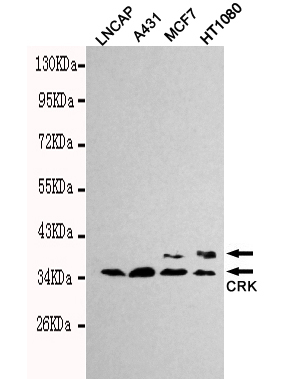- Home
- About
- Promotions
-
Products
-
Elisa Kits
- |
-
Primary antibodies
- |
-
Secondary antibodies
- |
-
Proteins
- |
-
IHC reagents
- |
-
WB reagents
- PonceauS Staining Solution
- PBST Washing Buffer, 10X
- 1.5M Tris-HCl Buffer, pH8.8
- 1M Tris-HCl Buffer, pH6.8
- 10% SDS Solution
- Prestained Protein Marker
- TBST Washing Buffer, 10X
- SDS PAGE Loading Buffer, 5X
- Stripping Buffered Solution
- Tris Buffer, pH7.4, 10X
- Total Protein Extraction Kit
- Running Buffer, 10X
- Transfer Buffer, 10X
- 30% Acr-Bis(29:1) Solution
- Tris电泳液速溶颗粒
- PBS(1X, premixed powder)
- TBS(1X, premixed powder)
- 快速封闭液
- 转膜液速溶颗粒
- Chemical reagents
- News
- Distributor
- Resources
- Contact
- Home
- >
- Info
- >
- CrkII mouse mAb
- >
- Go Back
CrkII mouse mAb
- Catalog No.:YM1341
- Applications:WB
- Reactivity:Human
- Fields:
- >>MAPK signaling pathway;>>ErbB signaling pathway;>>Rap1 signaling pathway;>>Chemokine signaling pathway;>>Focal adhesion;>>Fc gamma R-mediated phagocytosis;>>Neurotrophin signaling pathway;>>Regulation of actin cytoskeleton;>>Insulin signaling pathway;>>Growth hormone synthesis, secretion and action;>>Bacterial invasion of epithelial cells;>>Shigellosis;>>Yersinia infection;>>Human cytomegalovirus infection;>>Human immunodeficiency virus 1 infection;>>Pathways in cancer;>>MicroRNAs in cancer;>>Renal cell carcinoma;>>Chronic myeloid leukemia
- Immunogen:
- Purified recombinant human CrkII protein fragments expressed in E.coli.
- Specificity:
- This antibody detects endogenous levels of CrkII and does not cross-react with related proteins.
- Formulation:
- Liquid in PBS containing 50% glycerol, 0.5% BSA and 0.02% sodium azide.
- Source:
- Monoclonal, Mouse
- Purification:
- The antibody was affinity-purified from mouse ascites by affinity-chromatography using epitope-specific immunogen.
- Storage Stability:
- -15°C to -25°C/1 year(Do not lower than -25°C)
- Other Name:
- Adapter molecule crk;Avian sarcoma virus CT10 (v crk) oncogene homolog;CRK;CRK isoform 2;CRK isoform II;CRK_HUMAN;CRKII;FLJ38130;OTTHUMP00000115366;OTTHUMP00000198330;p38;Proto oncogene C crk;Proto-oncogene C-crk;v crk avian sarcoma virus CT10 oncogene homolog;v crk sarcoma virus CT10 oncogene homolog;v crk sarcoma virus CT10 oncogene homolog (avian).
- Background:
- This gene encodes a member of an adapter protein family that binds to several tyrosine-phosphorylated proteins. The product of this gene has several SH2 and SH3 domains (src-homology domains) and is involved in several signaling pathways, recruiting cytoplasmic proteins in the vicinity of tyrosine kinase through SH2-phosphotyrosine interaction. The N-terminal SH2 domain of this protein functions as a positive regulator of transformation whereas the C-terminal SH3 domain functions as a negative regulator of transformation. Two alternative transcripts encoding different isoforms with distinct biological activity have been described. [provided by RefSeq, Jul 2008],
- Function:
- domain:The C-terminal SH3 domain function as a negative modulator for transformation and the N-terminal SH3 domain appears to function as a positive regulator for transformation.,domain:The SH2 domain mediates interaction with SHB.,function:The Crk-I and Crk-II forms differ in their biological activities. Crk-II has less transforming activity than Crk-I. Crk-II mediates attachment-induced MAPK8 activation, membrane ruffling and cell motility in a Rac-dependent manner. Involved in phagocytosis of apoptotic cells and cell motility via its interaction with DOCK1 and DOCK4.,PTM:Phosphorylated on Tyr-221 upon cell adhesion. Results in the negative regulation of the association with SH2- and SH3-binding partners, possibly by the formation of an intramolecular interaction of phosphorylated Tyr-221 with the SH2 domain. This leads finally to the down-regulation of the Crk signaling pathway.,PTM:P
- Subcellular Location:
- Cytoplasm . Cell membrane . Translocated to the plasma membrane upon cell adhesion. .
- Expression:
- Embryonic lung,Epithelium,Eye,Lung,Placenta,

- Western blot detection of CrkII in Lncap,A431,MCF7 and HT1080 cell lysates using CrkII mouse mAb (1:1000 diluted).Predicted band size: 34kDa.Observed band size: 34kDa.




